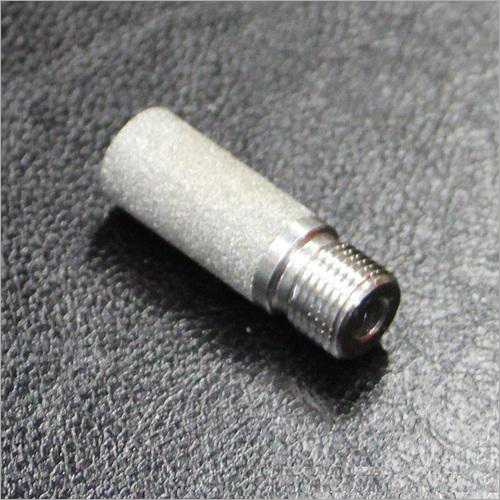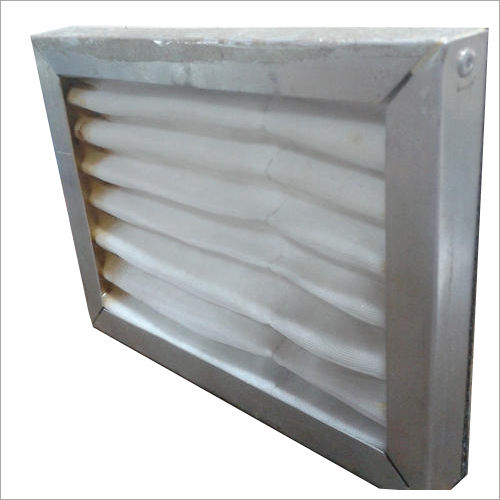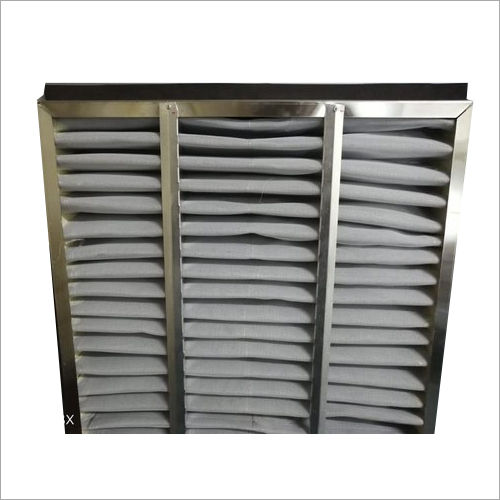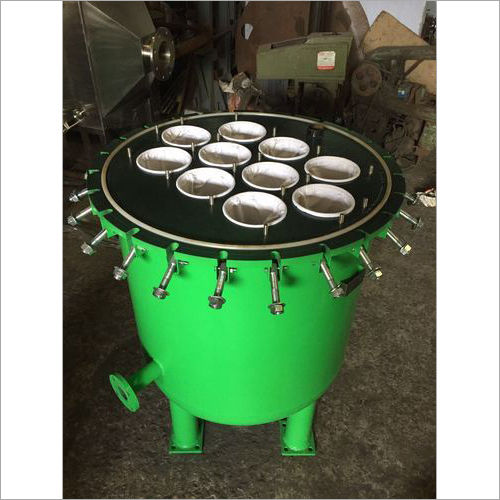- Home Page
- Company Profile
-
Our Products
- Industrial Cartridge Filters
- PP Yarn Wound And Spun Bonded Filter Cartridges
- Sintered Filter Disc and Knitted Mesh Pack
- Micro Perforation Filter Cartridges
- Sintered Spargers Filter Elements
- Sintered Bronze Filter Cartridges
- Wedge-wire - Slotted filter Cartridges
- Sintered SS316L Powder Filter Cartridges
- Bag Filter Systems For Liquid Filtration
- Conical Type Strainers and Strainers Elements
- Y And T Type Strainer
- Vent Filter and Conical Filter
- Root Blower Air Filter System
- Single and Multi Bag - Basket Filter Systems
- Catalayst Recovery Filter System
- Skid Mounted and Stage Type Filter Systems
- Duplex Filter System
- Multi Cartridges Filter Housing
- High pressure Filter Systems
- PP- PTFE -PVDF Lined Metallic Filter Housings
- MS PP-PFA-FEP Lined Filter System
- PP- PTFE -PVDF Strainers And Elements
- Safe Change Filter System
- BIBO Filter System
- Polypropylene Filter Housings
- HDPE Filter Housing
- Polycarbonate Filter Housing
- FRVE Filter Housing
- FRP Filter Housing
- Primary Air Intake Filters
- Woven Mesh and Sintered Multi Layer Filter Cartridges
- Filter Assemblies and Spare Parts
- Sparkler Filter
- Sintered Bronze Filter
- Gas Turbine Air Intake Filters
- Screen Filters
- Coalescing Filters
- Wedge Wire Filter Element
- PTFE Membrane Filters
- Air Pre Filter
- Self Cleaning Filter
- Self Cleaning Water Filter
- Disposable Filter Cartridges
- Industrial Water Filters
- Duct Mounted Panel Air Filter
- Dust Collecting Equipment
- Dust Collection Filter
- Bag In Bag Out Filter
- Compressed Air Filters
- Metal Filters
- Basket Filters
- Basket Strainer
- Industrial Basket Strainers
- Metallic Filter Housing
- Bucket Strainer
- Polishing Filter
- Gas Filtration Equipment
- Air Filtration Systems
- Sterilizing Air Filter
- Air And Gas Filter
- Pneumatic Filters
- Sintered Hastelloy Filter Cartridge
- Micron Filters
- Industrial Filter Cartridges
- MS Lined Cartridge Filter
- Porous Ceramic Filter
- Filter Media Pad
- Filter Disc
- Pocket Filters
- Panel Filter
- Pre Filter
- Cylindrical Strainer
- Filtration Equipment For Power Plant Industry
- Filtration Equipment For Textile Industry
- Filtration Equipment For Pharmaceutical Industry
- Hastelloy Filter Housing
- Hydrogen Peroxide Filter
- Vacuum Filters
- Cleanable Filter Elements
- SS Wire Mesh Filter Element
- S.S Wedge Wire Filter Element
- Sintered Bronze Filter Elements
- Sintered Sparger
- White Bicomponent Thermally Bonded Filters Cartridge
- High Pressure Air Filter
- Duplex Cartridge Filter
- SS Fabricated Filter Housing
- SS Cartridge Filter Housing
- Inline Filter Housings
- Bag And Cartridge Filter Housing
- Liquid Filter Housing
- SS Filter Housing
- PP Molded Filter Housing
- SS Bag Filter Housing
- Pharmaceutical Filter Housing
- BIBO Filter
- Oil Filtration Plant
- Bag Filter Housing
- Micron Cartridge Filter Housing
- High Pressure Filter Housing
- Multi Cartridge Filter Housing
- Filtration Plant
- Air Filter Housing
- Powder Coating Cartridge Filters
- Industrial Filter Housing System
- Self Cleaning Steel Filter
- PFA Lined Filter
- Duplex Filter
- Low Pressure Filter
- Liquid Filter
- Gas Filter Housing
- Filter Cartridges
- SS Filter Cartridge
- Sintered Powder Filter Cartridges
- Resin Bonded Filter Cartridges
- Yarn Wound Filter Cartridges
- Zeta Filter Module
- Resin Bonded Acrylic Fiber-Cellulose Filter Cartridges
- Capsule Filter Cartridges
- Absolute Pleated Filter Cartridge
- Pleated Paper Air Filter
- Sintered Polymer Filter Cartridges
- Sintered Ceramic Filter Cartridges
- Sintered PP Filter Cartridge
- Portable Filter Housing
- Sintered SS 316L Non-Woven Fiber Filter Cartridges
- Filters-Metal Mining & Refineries
- Filter Bags
- Filter Media
- Filter Housings
- Washable Filters
- Basket Filter Strainer
- Catalyst Recovery System
- PTFE Lined Fittings
- Culinary Steam Filter
- Water Demineralization Plant
- Air and Liquid Filter
- Industrial Cartridge Filters
- Applications
- Contact Us


Sintered Sparger
2000 INR/Unit
Product Details:
- Product Type Sintered Sparger
- Shape Round
- Usage Industrial
- Color Silver
- Material Other
- Type Pleated Depth Filter Cartridge
- Cartridge Style Double Open End
- Click to view more
X
Sintered Sparger Price And Quantity
- 2000 INR/Unit
- 1 Unit
Sintered Sparger Product Specifications
- Pleated Depth Filter Cartridge
- Double Open End
- Silver
- Industrial
- Sintered Sparger
- Round
- 99%
- Other
Sintered Sparger Trade Information
- 5 Unit Per Week
- 7 Days
Product Description
Sintered Sparger is an industrial tool which is used for the efficient delivery of the gas into a column of a flotation cell or a tank to ensure that bubbles are dispersed evenly throughout the container. It is widely used in the water treatment applications and various other industries such as chemical, food, oil and gas, beverages and pharmaceutical. It has a high diffusion rate due to the fine and dense pores which results in controlled operation. The shank of Sintered Sparger is provided with a series of threads for the easy and tight fastening.
Applications of Sintered Sparger:
Sintered spargers are porous, often metallic, devices used in various industrial processes to introduce gases into liquids or to provide aeration. They find applications in a wide range of industries, thanks to their efficient and reliable gas dispersion capabilities. Some of the common applications of sintered spargers include:
1. Biotechnology and Pharmaceutical Industry: Sintered spargers are used for aeration and oxygenation of cell cultures in bioreactors. They help provide oxygen to microbial cultures for fermentation and cell growth in bioprocessing applications.
2. Water Treatment: In water and wastewater treatment, sintered spargers are used to introduce air or oxygen into water to facilitate the growth of aerobic microorganisms that aid in the breakdown of organic matter and pollutants.
3. Chemical Reactions: Sintered spargers are used to facilitate chemical reactions in vessels or tanks by introducing gases like oxygen, hydrogen, or nitrogen into the reactant solutions. This is common in the chemical and petrochemical industries.
4. Food and Beverage Industry: In food and beverage processing, sintered spargers can be used for carbonation of beverages, oxygenation of wine, and aeration of food products, such as in the production of yogurt.
5. Mining Industry: In hydrometallurgical processes, sintered spargers can be used to introduce air or oxygen into leach tanks to aid in the dissolution of minerals or metals from ores.
6. Oil and Gas Industry: In enhanced oil recovery (EOR) processes, sintered spargers are used to inject gases like CO2 or nitrogen into oil reservoirs to increase oil recovery.
7. Chemical Engineering: Sintered spargers are employed in various chemical engineering processes, including gas-liquid reactions, stripping, and extraction processes.
8. Environmental Monitoring: Sintered spargers are used in laboratories and environmental monitoring to introduce calibration gases into gas chromatographs and other analytical instruments.
9. Pharmaceutical Formulations: Sintered spargers are used in the pharmaceutical industry to introduce gases or steam for sterilization and in formulation processes.
10. Agriculture: In hydroponic and aeroponic systems, sintered spargers are used to deliver oxygen to the roots of plants grown in soilless environments.
11. Aquaculture: They can be used in aquaculture systems to aerate water in fish tanks and ponds, providing dissolved oxygen for aquatic life.
12. Wine Production: Sintered spargers are used for the controlled oxygenation of wine during aging, a critical step in winemaking.
13. Mining and Metallurgy: In metallurgical processes, sintered spargers are used to introduce gases into molten metals to remove impurities and control alloy composition.
14. Ozone Generation: Sintered spargers can be used to introduce oxygen into ozone generators to produce ozone for various applications, such as water disinfection.
15. Environmental Remediation: They are used in soil and groundwater remediation to inject gases or chemicals into contaminated sites for the purpose of removing or neutralizing pollutants.
Benefits of Sintered Sparger:
Sintered spargers offer several benefits in various industrial applications due to their unique design and capabilities. Some of the key advantages of sintered spargers include:
1. Efficient Gas Dispersion: Sintered spargers are designed to create fine bubbles or distribute gases uniformly in a liquid. This efficient gas dispersion promotes better gas-liquid contact and mass transfer, improving the overall efficiency of processes like chemical reactions, oxygenation, and aeration.
2. Enhanced Mixing: Sintered spargers can improve mixing in tanks and reactors by promoting circulation and preventing the formation of dead zones. This is particularly beneficial in processes where uniform mixing is critical.
3. Controllable Gas Flow: They provide precise control over gas flow rates, making it easy to adjust and maintain the desired gas concentration in the liquid phase, which is essential in various applications.
4. Low Pressure Drop: Sintered spargers typically have a low pressure drop across the porous material, which means that they can introduce gases into a system without significantly impacting the system's overall pressure.
5. High Temperature and Corrosion Resistance: Many sintered spargers are made from materials like stainless steel or other high-temperature, corrosion-resistant alloys. This makes them suitable for use in harsh chemical and industrial environments.
6. Longevity: Sintered spargers are durable and have a long operational life, which reduces maintenance and replacement costs.
7. Hygienic and Sterile Options: In applications such as biotechnology and pharmaceuticals, sintered spargers can be designed for hygienic and sterile use, ensuring that they meet the stringent requirements of these industries.
8. Reduced Foaming: The fine bubbles produced by sintered spargers reduce the risk of excessive foaming, which can be a problem in certain processes and industries.
9. Energy Efficiency: Improved gas-liquid contact and mixing facilitated by sintered spargers can lead to energy savings as processes become more efficient.
10. Scalability: Sintered spargers can be designed in various shapes and sizes to suit different applications, making them scalable and adaptable to a wide range of industrial processes.
11. Environmental Benefits: In processes like water and wastewater treatment, sintered spargers help introduce gases for biological treatments, which can reduce the use of chemicals and the environmental impact of these processes.
12. Precise Gas Delivery: They allow for precise and controlled delivery of gases, which is essential in applications like gas chromatography, fermentation, and other laboratory and industrial processes.
13. Improved Product Quality: In applications like brewing and winemaking, sintered spargers can help control the oxygenation of the product, ensuring higher quality and consistency.
FAQ:
1. What is a sintered sparger?
Ans: A sintered sparger is a porous device typically made of metal or ceramic, used to introduce gases into liquids. It contains small, precisely sized openings that disperse gases in the form of fine bubbles.
2. What are the common applications of sintered spargers?
Ans: Common applications include aeration and oxygenation in bioreactors, water treatment, chemical reactions, food and beverage processing, oil and gas recovery, chemical engineering, environmental monitoring, and more.
3. How do sintered spargers work?
Ans: Sintered spargers work by forcing a gas through their porous structure, which breaks it into tiny bubbles. These bubbles rise through the liquid, facilitating gas-liquid contact and mixing.
4. What types of materials are sintered spargers made from?
Ans: Sintered spargers are typically made from materials like stainless steel, titanium, ceramics, or porous plastics, chosen based on factors such as chemical compatibility and temperature resistance.
5. How do I select the right sintered sparger for my application?
Ans: The choice depends on factors like the type of gas, gas flow rate, temperature, pressure, and the specific process requirements. Consult with a supplier or engineer with expertise in your application area for guidance.
6. What are the advantages of using sintered spargers?
Ans: Sintered spargers offer efficient gas dispersion, enhanced mixing, controllable gas flow, low pressure drop, high-temperature and corrosion resistance, longevity, and scalability, among other benefits.
7. Can sintered spargers be cleaned and sterilized for use in bioprocessing applications?
Ans: Yes, many sintered spargers can be cleaned and sterilized using methods such as autoclaving, CIP (Clean-in-Place), or SIP (Sterilize-in-Place) to meet the hygiene requirements of bioprocessing.
8. Do sintered spargers require maintenance?
Ans: Sintered spargers are durable and require minimal maintenance. Regular cleaning to prevent clogging is recommended, and replacement may be necessary after a very long operational life.
9. Can sintered spargers be customized for specific applications?
Ans: Yes, sintered spargers can be customized in terms of size, shape, material, and pore size to suit the unique requirements of different applications.
10. Are there environmental benefits to using sintered spargers?
Ans: Yes, in some applications, such as water treatment, sintered spargers can reduce the use of chemicals and improve the environmental sustainability of processes.
11. Can sintered spargers be used in high-pressure applications?
Ans: Some sintered spargers are designed to withstand high pressures, but it's essential to select the appropriate type that can handle the specific pressure requirements of your application.
12. Are there alternatives to sintered spargers for gas-liquid dispersion?
Ans: Yes, alternatives include perforated pipes, diffusers, and mechanical agitators, but sintered spargers are preferred for their fine bubble generation and efficiency.
Tell us about your requirement

Price:
Quantity
Select Unit
- 50
- 100
- 200
- 250
- 500
- 1000+
Additional detail
+91
Email









 Call Me Free
Call Me Free
